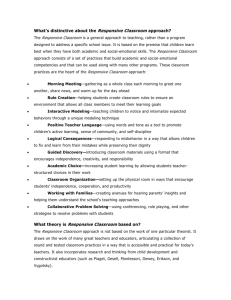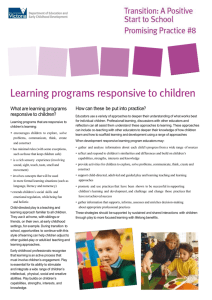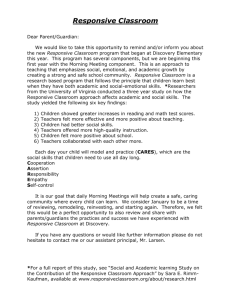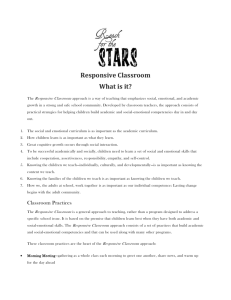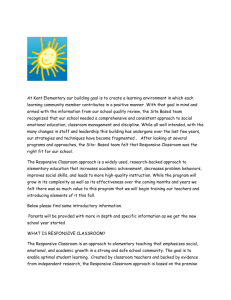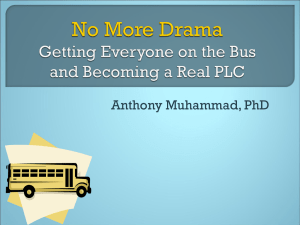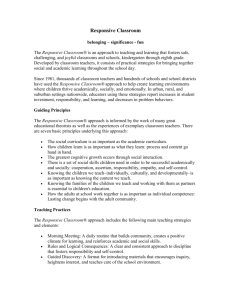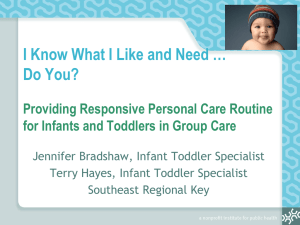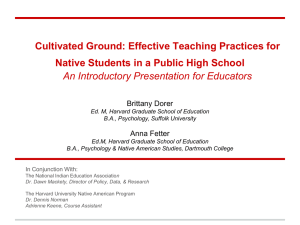November 7th School Culture (1.98MB PPT)
advertisement
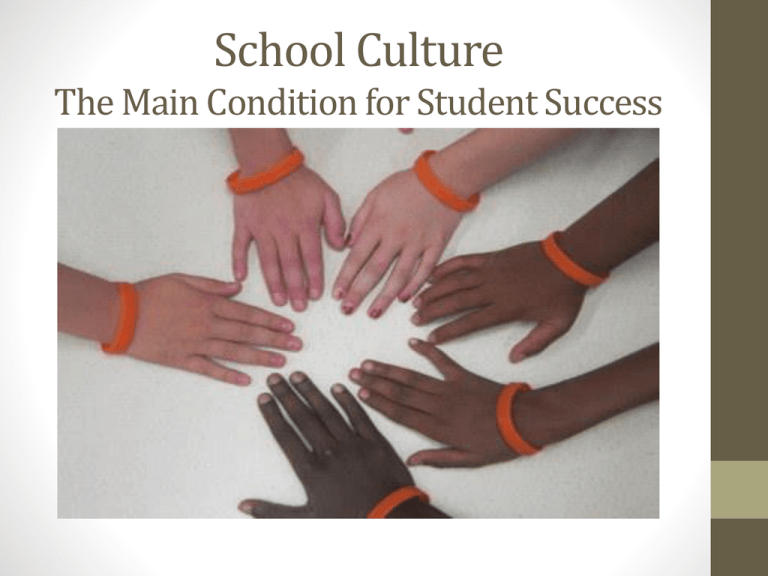
School Culture The Main Condition for Student Success Introductions My Story Forest Hills Elementary …Leading the Way The Power of School Culture • Positive School Culture • Educators have an unwavering belief in the ability of all their students to achieve success, and they pass that belief on to others in overt and covert ways. • Educators create policies and procedures and adopt practices that support their belief in the ability of every student The Power of School Culture • Toxic School Culture • Educators believe that student success is based upon students’ level of concern, attentiveness, prior knowledge, and willingness to comply with the demands of the school, and they articulate that belief in overt and covert ways. • Educators create policies and procedures and adopt practices that support their belief in the impossibility of universal achievement. Will and Skill Will…is the belief that all children can learn and perform academically. Educators must be the leaders of this will within their school culture! Skill…is the use of responsive instruction that is the practical key to ensuring students learn at high levels. The Reform Process Requires a combination of…. • Will Development • Developing the learning environment • Skill Development • Developing instruction It Takes Will… Strong Beliefs, High Expectations, Courage, Passion and Persistence Foundational to our Work •Know Yourself •Know the People who Surround You •Be Clear about Your Role as a Leader (Moral Purpose) Discuss… Your personal will and commitment to educate every child. Do you have personal or professional barriers to believing every child is capable of success? Your colleagues will and commitment to educate every child. Are there areas you need to help your colleagues address? Cultural Change “Cultural change is difficult to accomplish. It cannot be gained through force or coercion. It requires leaders adept at gaining cooperation and skilled in the arts of diplomacy, salesmanship, patience, endurance, and encouragement. It requires an ability to deal with beliefs, policies, practices, and institutions that have been established to buffer educators from change and accountability.” ~A. Muhammad Role of the Principal “The school principal is the key person in developing trust, both by demonstrating it him/herself and in fostering a culture of trusted relationships.” “Trust with a strong press for moral purpose produces very tough cultures that work diligently inside and outside the school to get results.” ~M. Fullan Trust of Capability • Respect people’s knowledge, skills and abilities • Respect people’s judgment • Surround yourself with excellence • Develop others • Support people in learning new skills • Involve others and seek their input Trust of Character • Manage expectations • Establish boundaries • Anticipate barriers • Honor agreements • Be consistent • Delegate appropriately • Model and be willing to do others’ jobs • Be visible Trust of Disclosure • Share information • Be honest • Admit your mistakes • Give and receive constructive feedback • Take the high ground – don’t blame • Respect confidentiality • Speak with optimism and good purpose • Have difficult conversations • Empower others Trust is a Must “The biggest dilemma facing all leaders with moral purpose is what to do if you don’t trust the competence and motivation of the people you are expected to lead.” M. Fullan ~ Collegial Culture Requires Effective Communication • • • • • • Power of continuous feedback Conditions supporting collaboration Classroom visits results in credibility Support is not synonymous with ‘agree with’ Data matters Principal shared responsibility – teachers’ performance and student achievement • Teacher Talks • Teacher (s) accountability • Opportunity for reflection, program adjustment, collaboration Managerial Culture Requires Leader Influence • Member Buy-in and Control over Policies, Practices, and Procedures in a School • Investment in Colleagues • Language and Behavior of culture’s members is influenced by the leader • Shared Responsibility for Success of Students • Shared Accountability • All members (including the principal) sees themselves as learners first Discuss… • How would you describe the level of trust between you and those whom you lead? • How do you view yourself in ‘influencing’ your colleagues? • How do you picture student achievement in three years and how will you get there? • What criteria do you use to decide when to have a one-to-one talk with a teacher about a problem? It Takes Skill…. Strong school wide and classroom management, academic vocabulary, academic literacy, and an environment focused on learning Aligning Will with the Skill • Relationship with Students • Culture of the Classroom • Emphasis on Rigor and Relevance • Professional Characteristics • Emphasis on learning ALL THE TIME Responsive Pedagogy 1. What do we want students to learn? 2. How will we know if students have learned it? 3. How will we respond when students have not learned it? 4. How will we respond when students already know it? Practices that Support Responsive Pedagogy… • Responsive Classroom Management • Responsive Academic Vocabulary • Responsive Academic Literacy • Responsive Learning Environment Structures that Support Responsive Pedagogy • Schedules • Staffing Models • Supervision Models • Financial Resource Allocation • Transportation Support • Parent Involvement • Student Resource Support What will we do differently that will make the biggest difference? Discuss… • Are there practices and structures supporting responsive pedagogy currently occurring at your school ? • What types of opportunities are there for collaborative, reflective discussions about instruction at your school? • Who are the underserved students in your school and therefore the student who will most benefit from a responsive pedagogy? Learning ALL the Time • • • • • • High expectations are everywhere Learning targets are known to students Student goal setting is common practice High student engagement is consistent Best practices are used to differentiate instruction Consistent monitoring of student learning occurs • Program adjustments are made regularly • Emphasis is placed on results • Views results as a reflection of the teacher • Collaborative: Views work as part of the whole (PLC model) Culture in the Context of Supervision • Maintain high expectations for students and staff • Share leadership – stay engaged in learning /teaching process • Create conditions for collaboration • Demonstrate a value for data; use it regularly • Ensure a laser focus on students and learning – everything must have a purpose • Address the barriers to learning • Reinforce learning by engaging families • Employ systems for supporting students’ social, emotional and academic needs …Leading the Way
